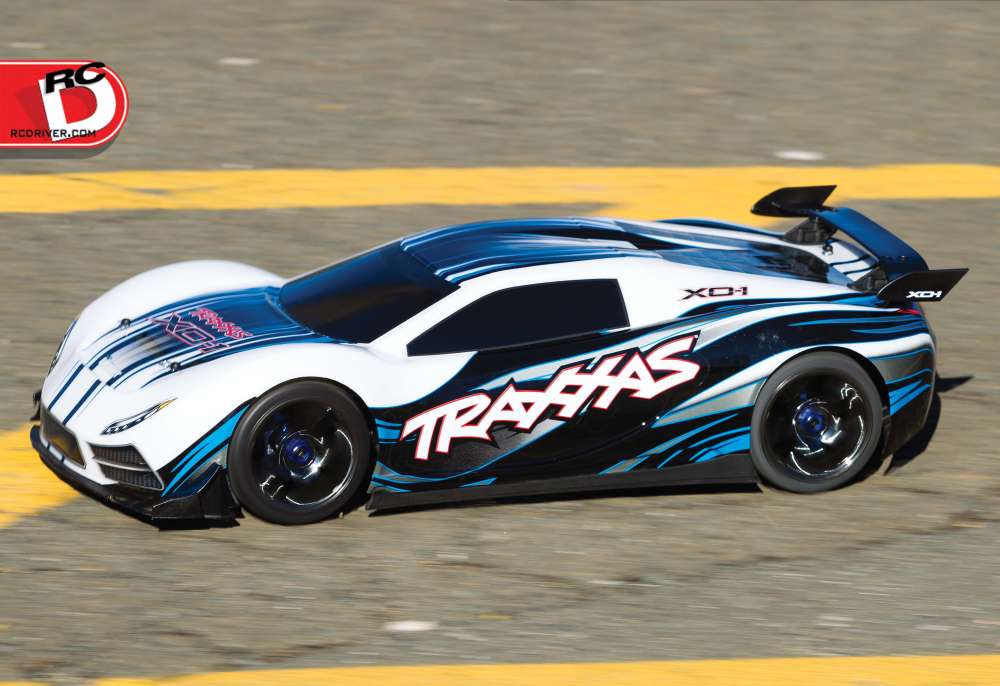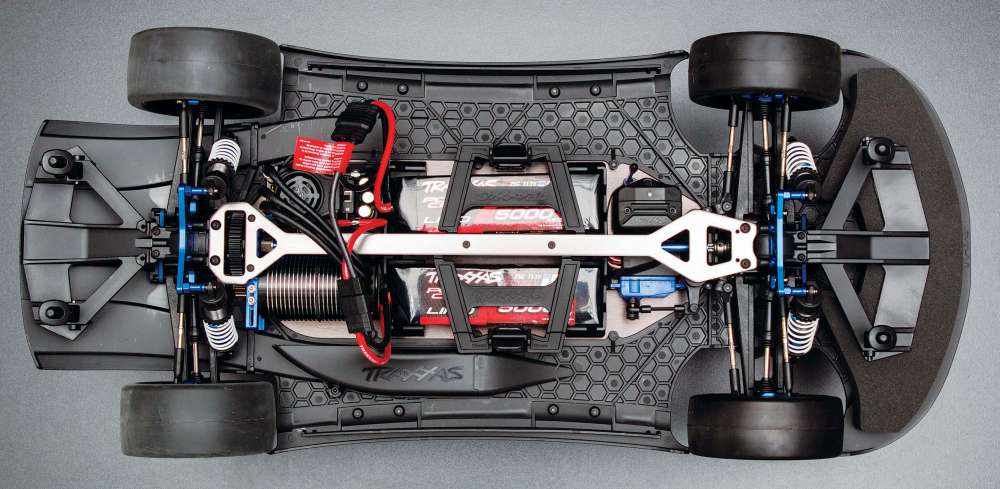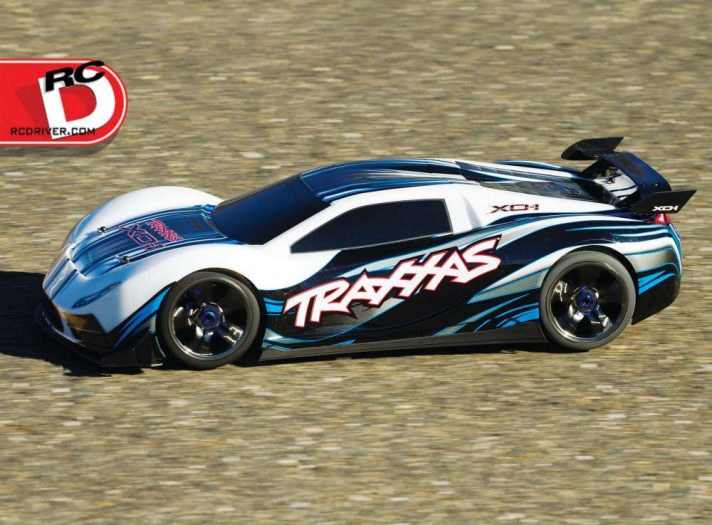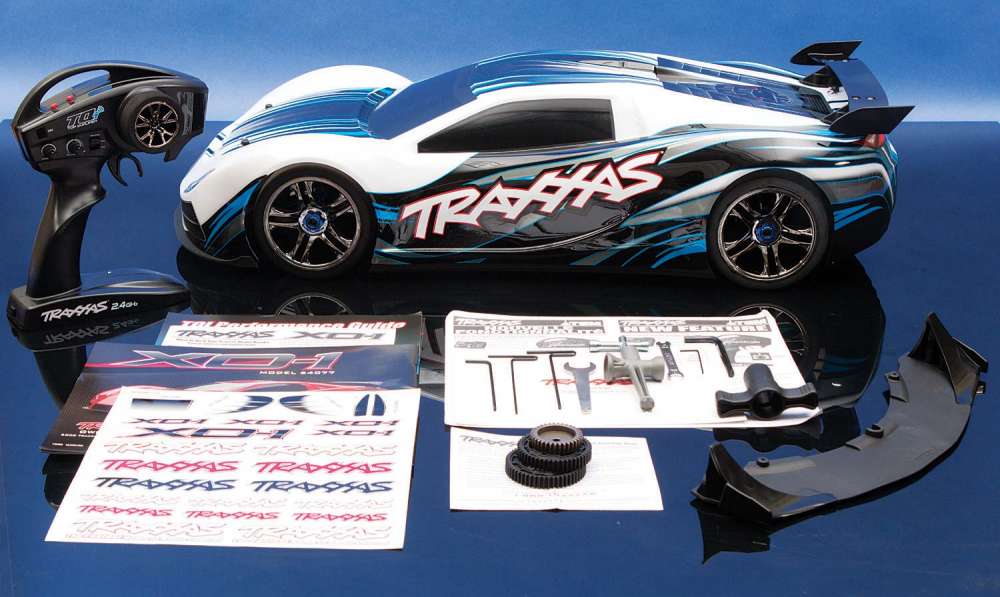Tame the Beast!
I cannot think of any other vehicle that got as much attention as the original Traxxas XO-1 when it was released just a couple of years ago. This 1/7-scale on-road monster caught everyone off guard with its unique chassis design and a Castle Creations powered system that could propel this car up to 100 mph in just a few short seconds. It goes without saying that the XO-1 was a massive hit, but it was also pretty challenging to drive, especially under anything less than ideal conditions. With the advancement of radio technology and control systems, it was only a matter of time before Traxxas threw us a bone in handling this rocket by way of adding the TSM (Traxxas Stability Management) system. This electronic aid helps tame the huge amounts of power and is fully customizable to the user via the included transmitter or free smartphone app. How does the TSM work in the Traxxas XO-1? We put this newest version through the ringer to help you guys decide if this model is right for you.
AT A GLANCE
WHO MAKES IT: Traxxas
WHO IT’S FOR: Advanced Drivers
PART NUMBER: 64077-3
HOW MUCH: $785.95
BUILD TYPE: RTR
PROS
• 100 mph in an RTR!
• Traxxas TSM helps tame the ridiculous power
• Castle Creations electronics capable of handling up to 6-cell LiPos
• Large 1/7-scale allows for unparalleled stability under high and low speed operations
• Traxxas Link module is great for on the fly telemetry and tuning
• Excellent body and chassis design allow for high speed runs with optimal downforce
• Excellent components make durability upgrades a thing of the past
CONS
• Not everyone has a large, smooth area to tap the full potential of the XO-1
REVIEWER’S OPINION
When Traxxas first released the XO-1 it was hands down one of the most ridiculous and fun on road cars to hit the market and it seemed to catch plenty of hobbyists’ attention. But there is such a thing as too much power and unless you had a perfectly prepped race track it was hard to tap the full potential of the vehicle. Now that Traxxas TSM technology is included on the XO-1, it allows for that extra bit of stability we all wanted on an otherwise excellent model. And the best part is that the TSM can be turned off and on with just the twist of a transmitter control.
TOOLS AND ACCESSORIES INCLUDED
• (2) 4-way wrenches
• L wrenches
• 8mm/4mm Turnbuckle tool
• 17mm wheel wrench
• Shock Wrench
• High speed 34 tooth pinion gear
• 100 mph splitter
ITEMS NEEDED
• 4 “AA” alkaline batteries for transmitter
• Two LiPo battery packs (2-cell or 3-cell)
ITEMS USED
• (2) Traxxas Power Cell 5000mAh 11.1v 3-Cell LiPo
HOP-UPS WE RECOMMEND
• Sway bar kit, XO-1 (front and rear), 6498, $25.00, The only extra thing I wish the XO-1 came with was a set of sway bars. This should aid in smoother turns and more balanced lateral weight transfer and can potentially allow for an even more aggressive suspension setup.
FEATURE BREAKDOWN
The very first thing I noticed when I removed the body shell was the extremely well thought out and designed chassis. The heart of the chassis is a nice, beefy 3mm aluminum flat plate that holds everything together and helps keep a nice low center of gravity. Just to add some extra durability and stiffness Traxxas added a long top aluminum brace which also helps to protect the driveline. Attached to the aluminum plate are composite components which keep the bottom of the vehicle completely flat, similar to the underside of a fullscale race car. The underside then transitions to front and rear aerodynamic aids. The front of the XO-1 incorporates a splitter and canards to add downforce and help in high-speed stability. The rear of the car features a huge diffuser that looks downright mean, but is fully functional as well. I really appreciate the details Traxxas thought of such as including a duct that draws
cooler air over the motor to keep the temperatures under control.
Sometimes an RTR aimed at a more general audience lacks tuning options as the typical user is generally happy with the out of box setup. Thankfully, the Traxxas XO-1 breaks this mold by offering plenty of tuning options. Almost every suspension component can be tweaked with a level of adjustability that I would expect on any high end dedicated racer. All four shocks are threaded for quick ride height adjustments along with plenty of shock mounting positions in the thick aluminum shock towers. Even the roll center can be tweaked so when you change the position of the threaded turnbuckles (for camber angle adjustments), the overall balance will not get upset. Bump steer is also adjustable by flipping the tie rod ball one way or the other. The only option I wish was included are adjustable sway bars, but this can be purchased from Traxxas as an optional hop-up (and I would recommend it).
Steering duty is handled by the tried and true Traxxas 2075 waterproof digital servo. This servo handles much more intense bashing duty on Traxxas’ other model lineups, and seems to do just fine on the XO-1. The steering servo is attached to a dual-bellcrank setup with an adjustable servo saver. Threaded steel turnbuckles allow for toe angle adjustments and have captured ball ends to avoid them popping off.
Traxxas and Castle Creations teamed up to provide an amazing power system for the XO-1. The speed control is a specially modified Mamba Monster speed control with integrated capacitors and a unique software program specifically designed for the Traxxas XO-1 . I used to think that the “standard” Mamba Monster motors were enormous until I saw the Traxxas/Castle Big Block motor that comes with this RTR. This thing is absolutely gigantic and obviously is the perfect match for this 1/7- scale vehicle. For a vehicle to handle such a beastly power system, the driveline components had better be up to snuff, and the XO-1 is no exception. First a large machined aluminum motor mount keeps the Big Block brushless motor in place. The motor and pinion gears are Mod 1, which are superior for large scale radio control vehicles with the larger spline size. The spur gear houses Traxxas’ own Cush drive system, which operates similar to a slipper clutch but has less wasted energy by utilizing internal dampers. Since the driveshaft is so long, Traxxas went with a hallow extruded aluminum construction to keep unsprung weight to a minimum while still retaining the durability required. With so much power running through the system every component must be extra durable and this includes everything down to the differentials. The XO-1 uses Revo-spec diffs which are tuned with various diff oils, like any high end racer would. 17mm hex hubs help transmit the power to the wheels and the larger size will help reduce any chance of stripping. Attached to the wheels are belted tires, such a construction will prevent the tires from ballooning at high speeds.
To go along with the expertly engineered chassis, the included body has maximum downforce in mind and definitely looks the part. Even on the shelf this thing looks like it is going too fast and in my opinion is one of the best looking body shells on the market. When mounted, the body fits right in with the chassis and integrates seamlessly with the front canards. The black chrome spoked wheels look right at home with the body design and color choices as well.
What really separates this version of the Traxxas XO-1 with the last iteration is the inclusion of the TSM (Traxxas Stability Management) equipped radio gear. This allows for an adjustable level of electronic aided inputs to help keep the XO-1 going in the direction the user intends. With so much power on tap, this is a welcome change and most users probably will end up using TSM to enhance their driving experience. The TSM and other features integrate seamlessly with the Traxxas Link app, which works on both Apple and Android smartphones. This program is amazing with tons of telemetry data and easy ways to change speed control settings along with plenty of other features. This app is required to tap the full 100 mph potential of the XO-1, otherwise there is an electronic limited governor set around 50 mph. Aside from the app the Traxxas TQ transmitter has the capability to make all sorts of
adjustments commonly found on high end radios, it just takes some getting used to the LED patterns and thankfully Traxxas includes some of the best manuals in the business to aid you.
Traxxas XO-1 ON THE TRACK
Obviously the first thing I wanted to do was test the acceleration and speed of the Traxxas XO-1 and I am not going to lie and say that I will ever get tired of flat out full throttle flybys. Even with the standard gearing set installed, the car has such brutal acceleration I half expected to see the tires burning after each pass. While it is no secret that the XO-1 is in fact capable of 100 mph (check YouTube if you still don’t believe it), I wanted to find out more about how the TSM system helps me handle the power on less than ideal conditions (something I would expect most users will end up running their XO-1 on as well). It is important to note that although you may not have a full fledged on-road course to use, a large area like an empty parking lot is necessary because you will run out of real estate really quickly. My testing area did have a few patches of light sand and some small uneven areas which ended up being the perfect testing spot for the TSM system. The user has two methods of controlling the percentage of electronic aid, via the transmitter or the Traxxas Link app. The Traxxas TQ transmitter by default uses the multifunction knob to control the amount of TSM enabled real time. This made it very easy for me to immediately see the effects of the stability system. I tested both extremes first, each one by jamming on the throttle trigger without hesitation. With the TSM off, it was hit-or-miss as to whether the Traxxas XO-1 was pointed in the same direction as when I started, which I honestly would expect because I am not building up speed in a normal fashion. With the TSM system cranked up to max the XO-1 would not spin out for normal speed runs even if I hit a light patch of sand along the way. With so much power under the hood it is quite incredible how quickly this system can make corrections at these speeds. A couple of times I did notice what I believe was the TSM system trying to over-correct, which results in a slight side to side wobble, so I adjusted the knob until this went away. At the end of my testing I had the TSM at around 40% which helped me keep the XO-1 straight without feeling overbearing or sluggish.
Sometimes stability systems can feel a bit restrictive in how it reacts to steering inputs so the next step in my testing was to see how the TSM affects cornering performance. The box stock tune is inherently stable and this does end up resulting in the Traxxas XO-1 having some understeer before the Castle power system breaks traction from the tires. This results in unintentional 180s most of the time. It is quite the challenge finding the right balance of throttle input and steering angle all while nailing the apex of a turn. Once I dialed in the TSM system, I noticed I was able to get on the throttle quicker and let the electronics worry about keeping the XO-1 in a balanced state. Using the same 40% setting worked for me, but I have always been a smoother racer. I could definitely see higher values being useful for those with a heavier trigger finger and do believe that these users will see an even greater benefit from TSM. The best part of the stability system was I still had the ability to pull off awesome power slides, a testament to how unobtrusive the electronic aid really is.
Even though I already could see the benefits of the TSM system, I actually found the most benefit to come in the braking performance of the vehicle. I could not believe the difference between using TSM and driving without it. Without the TSM slowing down the Traxxas XO-1 was a scary proposition. A vehicle traveling at these high speeds required perfect control of the vehicle while braking to prevent extra unnecessary skidding and short stopping time. When I turned the TSM on, I could not believe how quickly the XO-1 came to a stop when traveling at high speeds. I did not measure the exact distance but it certainly felt like the stopping distance was at least halved with the system on. With such a large vehicle, braking power is the most important factor in keeping both the model and user safe and I am thrilled with the performance that the TSM adds.
During my testing I did have an unfortunate accident when I was trying to test the car at its limits and was sweating when I brought the car back, unsure of what damage I had caused. After it was all said and done the only part that had a small crack was the front plastic skid plate and I was ecstatic. With a crash at these high speeds something has to take the brunt of the damage and I was glad that the XO-1 had a setup that allowed for the cheapest component to
soak up all of the damage. Any vehicle would have had some time of broken part, so this is no fault of the car and actually shows how great the engineering of this particular model really is. Since I did end up having to do some surgery to my XO-1, I have to say Traxxas was on the ball with designing this chassis to be easy to work on. It only takes a few screws to get to virtually anything and replacing any part should only take a few minutes, avoiding any unnecessary frustration.
Traxxas XO-1 SPECS AND TUNING OPTIONS
DIMENSIONS
LENGTH: 27 in. (686mm)
WIDTH: 11.81 in. (300mm)
WHEELBASE: 15.9 in. (404mm)
WEIGHT: 8.6 lbs. (3.9kg) without batteries
BODY, WHEELS AND TIRES
BODY: ProGraphix painted on-road
WHEELS: 3.3” Split-Spoke black chrome
WHEEL ADAPTER TYPE: 17mm hex
TIRES: Belted on-road slicks
SUSPENSION
TYPE: 4-wheel independent
SHOCK POSITIONS: (F) 3-tower, 4-arm, (R) 3-tower, 4-arm
CAMBER: Adjustable turnbuckles
ROLL: Adjusted via shock tower
WHEELBASE: Fixed
RIDE HEIGHT: Threaded aluminum bodied shocks
MISC: Adjustable bump steer
STEERING
TYPE: Dual bellcrank
TOE: Adjustable turnbuckles
CHASSIS
TYPE: Dual Plane
MATERIAL: 6061-T6 Aluminum
THICKNESS: 3mm
DRIVETRAIN
TYPE: Shaft driven 4WD
TRANSMISSION: Rear mounted single speed
DIFFERENTIAL: Steel bevel
CLUTCH TYPE: Cush Drive™
GEAR RATIO: 9.36 stock, (optional speed gears included)
BEARINGS: Full set of shielded
Traxxas XO-1 RATING TALLY
Opinion: 9
Performance – Acceleration: 10
Performance – Steering: 8
Performance – Handling: 8
Performance – Durability: 9
Feature Breakdown: 10
Overall Value: 8
WRAP UP
I have to admit, when the Traxxas XO-1 was first released I was not sure how useable this vehicle would be for me as I like to run my on-road cars in all sorts of areas, not just race tracks. But after the inclusion of the Traxxas TSM system, I immediately could see how this awesome vehicle can see more use and enjoyment for the average driver. Because the system is fully customizable, don’t be afraid to try it out and see how well it works for you. Some people will probably want the TSM to kick in more than others and that is the beauty of the system, it is so easy to adjust with the TQ transmitter or Traxxas Link app. Not to mention, who can get tired of hitting triple digit speeds in RC?
Words: Mark Ronge
Photos: Edwin Rodriguez
LINKS
Traxxas, traxxas.com
Castle Creations, castlecreations.com
 RC Driver The Best In RC Car & Truck News, Reviews & Video
RC Driver The Best In RC Car & Truck News, Reviews & Video 























I am adicted to SPEED and not Bashing. Must be the driving class I took at SILVERSTONE and the MCLAREN SENNA I got to lap the track in. If the RC Car world was surprised by the XO-1, will they be surprised again when a 1:5 scale XO-2 with a CASTLE MAMBA on each wheel ? I can only hope that TRAXXAS does it 🙂